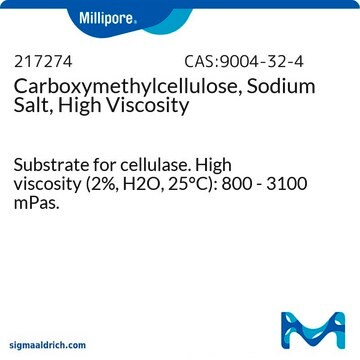Products may be shipped at a different temperature than the recommended long-term storage temperature. If the product quality is sensitive to short-term exposure to conditions other than the recommended long-term storage, it will be shipped on wet or dry-ice. If the product quality is NOT affected by short-term exposure to conditions other than the recommended long-term storage, it will be shipped at ambient temperature. As shipping routes are configured for minimum transit times, shipping at ambient temperature helps control shipping costs for our customers. For more information, please refer to the Storage and Transport Conditions document: https://www.sigmaaldrich.com/deepweb/assets/sigmaaldrich/marketing/global/documents/316/622/storage-transport-conditions-mk.pdf
おすすめの製品
フォーム
powder
品質水準
自己発火温度
698 °F
標識化の程度
0.9 carboxymethyl groups per anhydroglucose unit
粘度
2500-6000 cP
mp
270 °C (dec.)
SMILES記法
[Na].OC(C(O)C(O)C=O)C(O)CO.OC(=O)C
InChI
1S/C6H12O6.C2H4O2.Na/c7-1-3(9)5(11)6(12)4(10)2-8;1-2(3)4;/h1,3-6,8-12H,2H2;1H3,(H,3,4);
InChI Key
DPXJVFZANSGRMM-UHFFFAOYSA-N
類似した製品をお探しですか? 訪問 製品比較ガイド
関連するカテゴリー
詳細
保管分類コード
11 - Combustible Solids
WGK
WGK 1
引火点(°F)
Not applicable
引火点(℃)
Not applicable
個人用保護具 (PPE)
Eyeshields, Gloves, type N95 (US)
適用法令
試験研究用途を考慮した関連法令を主に挙げております。化学物質以外については、一部の情報のみ提供しています。 製品を安全かつ合法的に使用することは、使用者の義務です。最新情報により修正される場合があります。WEBの反映には時間を要することがあるため、適宜SDSをご参照ください。
Jan Code
419338-1KG:
419338-100G:
419338-BULK:
419338-VAR:
この製品を見ている人はこちらもチェック
-
How is shipping temperature determined? And how is it related to the product storage temperature?
1 回答-
役に立ちましたか?
-
-
How can I determine the shelf life / expiration / retest date of this product?
1 回答-
If this product has an expiration or retest date, it will be shown on the Certificate of Analysis (COA, CofA). If there is no retest or expiration date listed on the product's COA, we do not have suitable stability data to determine a shelf life. For these products, the only date on the COA will be the release date; a retest, expiration, or use-by-date will not be displayed.
For all products, we recommend handling per defined conditions as printed in our product literature and website product descriptions. We recommend that products should be routinely inspected by customers to ensure they perform as expected.
For products without retest or expiration dates, our standard warranty of 1 year from the date of shipment is applicable.
For more information, please refer to the Product Dating Information document: https://www.sigmaaldrich.com/deepweb/assets/sigmaaldrich/marketing/global/documents/449/386/product-dating-information-mk.pdf役に立ちましたか?
-
-
Is this compound suitable for In vivo work?
1 回答-
This product has not been tested for in vivo or in vitro use. However, based on a review of the peer-reviewed papers, this material has been used in animal models. Please see the link below to review this publication: https://onlinelibrary.wiley.com/doi/10.1002/adhm.201400250
役に立ちましたか?
-
-
I am trying to buy CMC that is the same as the one used in batteries, but I am not sure how the Molecular weight would affect its properties. would it matter if it was high or low?
1 回答-
Carboxymethyl Cellulose Sodium serves as a binder for electrode materials in batteries. The molecular weight is irrelevant as long as all the components (active material, binder, conductive agent) can be immobilized on the current collector without obvious agglomeration or exfoliation. One reference suggested that lower molecular weight CMC produced 'lower charge transfer resistance, higher ion conductivity, better wettability with the electrolyte, and better Li+ mobility as LIB binder.' Should a lower molecular weight material be of interest, see CMC product 419274, average Mw ~90,000. See the links below to review this product page as well as the reference cited above.
419273, Sodium Carboxymethyl cellulose
https://www.sigmaaldrich.com/product/aldrich/419273Assembly and electrochemical testing of renewable carbon-based anodes in SIBs: A practical guide
https://www.sciencedirect.com/science/article/pii/S209549562200479XSodium carboxymethyl cellulose as a potential binder for hard-carbon negative electrodes in sodium-ion batteries
https://www.sciencedirect.com/science/article/pii/S1388248114001209役に立ちましたか?
-
アクティブなフィルタ
ライフサイエンス、有機合成、材料科学、クロマトグラフィー、分析など、あらゆる分野の研究に経験のあるメンバーがおります。.
製品に関するお問い合わせはこちら(テクニカルサービス)
![Poly[(o-cresyl glycidyl ether)-co-formaldehyde] average Mn ~870](/deepweb/assets/sigmaaldrich/product/structures/492/686/3e332037-f67b-49a2-8326-268fc7b0b900/640/3e332037-f67b-49a2-8326-268fc7b0b900.png)


